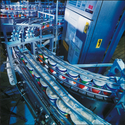Phoenix from the ashes: Manufacturing after the recession
5 October 2010It’s clear how hard the manufacturing industry has been hit by the downturn, but now the UK is officially out of recession, how can these manufacturers re-build their businesses and prosper again? Andy Hodgson, Business Sales Manager from Siemens Industry Automation and Drive Technologies, discusses the measures companies can implement to ensure they succeed post-recession.
During the recession, businesses were under extreme pressure to cut costs and as they now emerge from one of the most dramatic downturns in living memory, it can be easy to keep cutting back and even withhold the investment desperately required for growth as the recovery is still fragile and confidence is yet to return fully. Despite this backdrop, it is vital that they do not lose sight of the whole lifecycle costs and Total Cost of Ownership (TCO) of both machinery and its interaction into plant.
By taking a full view of the site, manufacturers can see where processes can be made more efficient and productive and therefore save them money. For instance, manufacturers will often use the services of several OEMs who will supply individual machines to add to a line. In addition to a multitude of control systems, components, software and methods of interfacing, this approach brings three potential issues for manufacturers.
Various control system architectures for machines and interfaces can lead to lower efficiency, as maintenance staff and operators work with a range of machines. Costs are also higher because of substantial spare parts inventories and increased staff training needs. Finally, the inability to network the individual components and the machines together will prevent data acquisition required in a ‘real-time’ format to monitor machine performance and improve OEE.
Manufacturers looking for success after the recession should apply a standardisation strategy called Optimised Packaging Line (OPL). This approach will mean they benefit from higher line efficiency, reduced training costs and less capital tied-up in stock of varying spare parts. Upfront investment to develop such an approach will soon reap rewards as the machines move from an initial CAPEX (capital expenditure) investment process to an OPEX (operational expenditure) phase.
This approach also ensures downtime is reduced as staff are alerted proactively by email or text as soon as a piece of equipment needs attention. While on-site staff will also be working more efficiently as they utilise common operating concepts.
Manufacturers should also note that investing in a totally integrated solution and standardising on an OPL strategy will reduce whole lifecycle costs substantially. Intelligent diagnostics highlight maintenance needs before they happen, while other efficiency gains include ease of operation, reduced training and production flexibility to ensure a measurable return on investment through a standardised approach.
Another area to be explored by costconscious manufacturers looking for sustainable success post-recession is avoiding exposure to risks posed by obsolete machinery and control systems which cannot be supported. Sites can often feature equipment which has been there over 20 years and although it may be in sound mechanical working order, it can present a number of significant risks to their business. If these risks come into being, manufacturers recovering from the recession could face substantial challenges.
Firstly, equipment on site will most probably lack sophisticated diagnostics. This means efficiency levels may not be consistent across the site as accurate notifications of maintenance required may not be available. Overall availability of the plant and finished product quality and output cannot be accurately assessed or guaranteed – a series of potentially challenging issues.
Another consideration for older machinery is the technical back-up and spare parts available. The OEM may no longer be able to provide what is needed to ensure productivity is maintained in the form of spare parts or service support required. This could be for a number of reasons – the OEM might not even still be in business.
For manufacturers looking to protect themselves from risk and succeed after the recession, it is worth undertaking an audit of machinery on site to effectively determine the levels of risk they are exposed to and potential measures which can be put in place to protect them from these risks. At a time when survival is still a main aim for many manufacturers, it is crucial they avoid any potential risks as the potential financial implications could have a significant impact on the speed of their recovery from the recession.
By taking a full view of the site, manufacturers can see where processes can be made more efficient and productive and therefore save them money. Siemens


